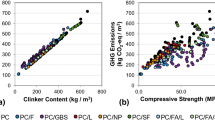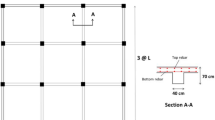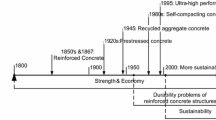Abstract
Design for materials is a sustainable design strategy to reduce CO2 emissions from the built environment. As the materials themselves may increase the sustainable properties of a structural system, this does not mean that the structural system itself has its most sustainable configuration; the selected design approach also plays a role. This study aims to analyse to which extent can the choice of different cement compositions combined with distinct design approaches lead to material reductions – and ultimately, to CO2 savings. To this, a reinforced concrete slab system was designed to control bending and shear. Two cement compositions (class C20/25) were considered: an average common mixture and a more modern mixture with a lower clinker amount. The results confirm that an optimised design configuration combined with a modern cement composition can lead to immediate CO2 savings. This stresses the need for practitioners to investigate the potential offered by optimising design approaches in combination with more production-energy-efficient materials.
Access this chapter
Tax calculation will be finalised at checkout
Purchases are for personal use only
Similar content being viewed by others
Notes
- 1.
This mixture refers to the production of a cement with an average composition of cements produced in Germany in 2015 [14].
References
United Nations Environment Programme (2021) 2021 Global Status Report for Buildings and Construction: Towards a Zero-emission, Efficient and Resilient Buildings and Construction Sector. Nairobi
KC S, Gautam D (2021) Progress in sustainable structural engineering: a review. Innov Infrastruct Solut 6(2):1–23. https://doi.org/10.1007/s41062-020-00419-3
Deutscher Ausschuss für Stahlbetonbau (DAfStb) (2014) Grundsätze des nachhaltigen Bauens mit Beton (GrunaBau). DAfStb-Richtlinie, Gelbdruck Juli 2014 (Dokument Vorstand D969). Beuth Verlag GmbH, Berlin
Wiens U, Hauer B, Hegger J, Dreßen T (2013) Nachhaltiges Bauen mit Beton. In: Zilch K, Diederichs CJ, Katzenbach R (Hrsg) Handbuch für Bauingenieure: Technik, Organisation und Wirtschaftlichkeit-Fachwissen in einer Hand. Springer-Verlag, Berlin. ISBN: 978-3-642-14450-9
Gervasio H, Dimova S (2018) Model for lifecycle assessment (LCA) of buildings. Publications Office of the European Union, Brussels
de la Fuente A, Casanovas-Rubio MDM, Pons O, Armengou J (2019) Sustainability of column-supported RC slabs: fiber reinforcement as an alternative. J Constr Eng Manag 145(7):04019042
Vilutiene T et al (2020) Assessing the sustainability of alternative structural solutions of a building: a case study. Buildings 10(2):36
Danatzko JM, Sezen H (2011) Sustainable structural design methodologies. Pract Period Struct Des Constr 16(4):186–190
Miller D, Doh JH, Peters T (2013) Optimised design selection and environmental impact assessment of alternative concrete slab construction methods. In: World congress on advances in structural engineering and mathematics
DIN EN 1992-1-1:2011 + AC:2010 (2011) Eurocode 2: Bemessung und Konstruktion von Stahlbeton- und Spannbetontragwerken – Teil 1-1: Allgemeine Bemessungsregeln und Regeln für den Hochbau. Deutsche Fassung EN 1992-1-1:2004 + AC:2010
DIN EN 1992-1-1:2015 (2015) Eurocode 2: Bemessung und Konstruktion von Stahlbeton- und Spannbetontragwerken – Teil 1–1: Allgemeine Bemessungsregeln und Regeln für den Hochbau, Ergänzung A1. Deutsche Fassung EN 1992-1-1:2004/A1:2014
DIN EN 1992-1-1+NA:2013 (2013) Nationaler Anhang – National festgelegte Parameter – Eurocode 2: Bemessung und Konstruktion von Stahlbeton- und Spannbetontragwerken – Teil 1–1: Allgemeine Bemessungsregeln und Regeln für den Hochbau
DIN EN 1992-1-1+NA/A1:2013 (2015) Nationaler Anhang – National festgelegte Parameter – Eurocode 2: Bemessung und Konstruktion von Stahlbeton- und Spannbetontragwerken – Teil 1-1: Allgemeine Bemesungsregeln und Regeln für den Hochbau. Änderung A1
German Federal Associations of Cement, Ready-mix Concrete, and Precast Concrete Element Industries (2021). https://epd-online.com/PublishedEpd/Download/9720, Accessed 10 Jan 2021
DLUBAL Software GmbH. Dlubal – RFEM 5.27. Student Version 5.27 (2021). http://www.dlubal.com/pt, Accessed 10 Jan 2021
German Federal Associations of Cement, Ready-mix Concrete, and Precast Concrete Element Industries (2021). https://www.beton.org/wissen/nachhaltigkeit/umweltproduktdeklarationen/, Accessed 10 Jan 2021
German Federal Associations of Cement, Ready-mix Concrete, and Precast Concrete Element Industries (2021). https://epd-online.com/PublishedEpd/Download/10521, Accessed 10 Jan 2021
Bau EPD GmbH (2021). https://www.bau-epd.at/epd/data/stahl-und-walzwerk-marienhuette-gmbh-betonstahl-2019-ecoinvent, Accessed 10 Jan 2021
German Federal Associations of Cement, Ready-mix Concrete, and Precast Concrete Element Industries. 2021. https://epd-online.com/PublishedEpd/Download/10990, Accessed 10 Jan 2021
Acknowledgements
The authors thank the company Schwenk Zement GmbH & Co. KG, Ulm, Germany for sharing data and knowledge about energy emissions of multiple cement types.
Author information
Authors and Affiliations
Corresponding author
Editor information
Editors and Affiliations
Rights and permissions
Copyright information
© 2023 The Author(s), under exclusive license to Springer Nature Switzerland AG
About this paper
Cite this paper
Feiri, T., Kuhn, S., Ricker, M. (2023). Immediate CO2 Savings Through Optimised Design Approaches: A Case Study of Reinforced Concrete Flat Slabs. In: Ilki, A., Çavunt, D., Çavunt, Y.S. (eds) Building for the Future: Durable, Sustainable, Resilient. fib Symposium 2023. Lecture Notes in Civil Engineering, vol 349. Springer, Cham. https://doi.org/10.1007/978-3-031-32519-9_30
Download citation
DOI: https://doi.org/10.1007/978-3-031-32519-9_30
Published:
Publisher Name: Springer, Cham
Print ISBN: 978-3-031-32518-2
Online ISBN: 978-3-031-32519-9
eBook Packages: EngineeringEngineering (R0)




